The main contents of this lesson are machine translation and related technologies, attention mechanism and Seq2seq model, Transformer
1, Machine translation and related technologies
Machine translation: when a text is automatically translated from one language to another, neural network is often used to solve this problem. Main features: output is a sequence of words rather than a single word. The length of the output sequence may be different from the length of the source sequence.
Import library
import os os.listdir('/home/kesci/input/') import sys sys.path.append('/home/kesci/input/d2l9528/') import collections import d2l import zipfile from d2l.data.base import Vocab import time import torch import torch.nn as nn import torch.nn.functional as F from torch.utils import data from torch import optim
Data preprocessing
Read in data set
with open('/home/kesci/input/fraeng6506/fra.txt', 'r') as f: raw_text = f.read() print(raw_text[0:1000])
Output result
Go. Va ! CC-BY 2.0 (France) Attribution: tatoeba.org #2877272 (CM) & #1158250 (Wittydev) Hi. Salut ! CC-BY 2.0 (France) Attribution: tatoeba.org #538123 (CM) & #509819 (Aiji) Hi. Salut. CC-BY 2.0 (France) Attribution: tatoeba.org #538123 (CM) & #4320462 (gillux) Run! Cours ! CC-BY 2.0 (France) Attribution: tatoeba.org #906328 (papabear) & #906331 (sacredceltic) Run! Courez ! CC-BY 2.0 (France) Attribution: tatoeba.org #906328 (papabear) & #906332 (sacredceltic) Who? Qui ? CC-BY 2.0 (France) Attribution: tatoeba.org #2083030 (CK) & #4366796 (gillux) Wow! Ça alors ! CC-BY 2.0 (France) Attribution: tatoeba.org #52027 (Zifre) & #374631 (zmoo) Fire! Au feu ! CC-BY 2.0 (France) Attribution: tatoeba.org #1829639 (Spamster) & #4627939 (sacredceltic) Help! À l'aide ! CC-BY 2.0 (France) Attribution: tatoeba.org #435084 (lukaszpp) & #128430 (sysko) Jump. Saute. CC-BY 2.0 (France) Attribution: tatoeba.org #631038 (Shishir) & #2416938 (Phoenix) Stop! Ça suffit ! CC-BY 2.0 (France) Attribution: tato
Preprocessing
Characters exist in the form of encoding in the computer. The space we usually use is \ X20, which is in the range of standard ASCII visible characters 0x20~0x7e. While \ xa0 belongs to the extended character set character in latin1 (ISO / IEC -1), representing the non breaking space (nbsp), which is beyond the gbk encoding range, and is a special character to be removed. In the process of data preprocessing, we need to clean the data first.
def preprocess_raw(text): text = text.replace('\u202f', ' ').replace('\xa0', ' ') # Remove confusion code out = '' for i, char in enumerate(text.lower()): # toggle case if char in (',', '!', '.') and i > 0 and text[i-1] != ' ': # Add spaces between words and punctuation out += ' ' out += char return out text = preprocess_raw(raw_text) print(text[0:1000])
Output result
go . va ! cc-by 2 .0 (france) attribution: tatoeba .org #2877272 (cm) & #1158250 (wittydev) hi . salut ! cc-by 2 .0 (france) attribution: tatoeba .org #538123 (cm) & #509819 (aiji) hi . salut . cc-by 2 .0 (france) attribution: tatoeba .org #538123 (cm) & #4320462 (gillux) run ! cours ! cc-by 2 .0 (france) attribution: tatoeba .org #906328 (papabear) & #906331 (sacredceltic) run ! courez ! cc-by 2 .0 (france) attribution: tatoeba .org #906328 (papabear) & #906332 (sacredceltic) who? qui ? cc-by 2 .0 (france) attribution: tatoeba .org #2083030 (ck) & #4366796 (gillux) wow ! ça alors ! cc-by 2 .0 (france) attribution: tatoeba .org #52027 (zifre) & #374631 (zmoo) fire ! au feu ! cc-by 2 .0 (france) attribution: tatoeba .org #1829639 (spamster) & #4627939 (sacredceltic) help ! à l'aide ! cc-by 2 .0 (france) attribution: tatoeba .org #435084 (lukaszpp) & #128430 (sysko) jump . saute . cc-by 2 .0 (france) attribution: tatoeba .org #631038 (shishir) & #2416938 (phoenix) stop ! ça suffit ! cc-b
participle
num_examples = 50000 source, target = [], [] for i, line in enumerate(text.split('\n')): # By space if i > num_examples: break parts = line.split('\t') # According to the tab, get the first two words if len(parts) >= 2: source.append(parts[0].split(' ')) target.append(parts[1].split(' ')) source[0:3], target[0:3]
([['go', '.'], ['hi', '.'], ['hi', '.']], [['va', '!'], ['salut', '!'], ['salut', '.']])
Build a dictionary
def build_vocab(tokens): tokens = [token for line in tokens for token in line] return d2l.data.base.Vocab(tokens, min_freq=3, use_special_tokens=True) src_vocab = build_vocab(source)
Load data set
def pad(line, max_len, padding_token): ''' //To make padding ''' if len(line) > max_len: return line[:max_len] return line + [padding_token] * (max_len - len(line)) def build_array(lines, vocab, max_len, is_source): ''' //Return the corresponding list and effective length, i.e. the length before padding ''' lines = [vocab[line] for line in lines] if not is_source: lines = [[vocab.bos] + line + [vocab.eos] for line in lines] array = torch.tensor([pad(line, max_len, vocab.pad) for line in lines]) valid_len = (array != vocab.pad).sum(1) #First dimension return array, valid_len def load_data_nmt(batch_size, max_len): # This function is saved in d2l. src_vocab, tgt_vocab = build_vocab(source), build_vocab(target) src_array, src_valid_len = build_array(source, src_vocab, max_len, True) tgt_array, tgt_valid_len = build_array(target, tgt_vocab, max_len, False) train_data = data.TensorDataset(src_array, src_valid_len, tgt_array, tgt_valid_len) train_iter = data.DataLoader(train_data, batch_size, shuffle=True) return src_vocab, tgt_vocab, train_iter src_vocab, tgt_vocab, train_iter = load_data_nmt(batch_size=2, max_len=8)
Encoder decoder structure
encoder: input to hidden state
decoder: hide state to output
Encoder decode basic code structure
class Encoder(nn.Module): def __init__(self, **kwargs): super(Encoder, self).__init__(**kwargs) def forward(self, X, *args): raise NotImplementedError class Decoder(nn.Module): def __init__(self, **kwargs): super(Decoder, self).__init__(**kwargs) def init_state(self, enc_outputs, *args): raise NotImplementedError def forward(self, X, state): raise NotImplementedError
Sequence to Sequence model
Sequence to Sequence model is an encoder decode structure. The model is as follows: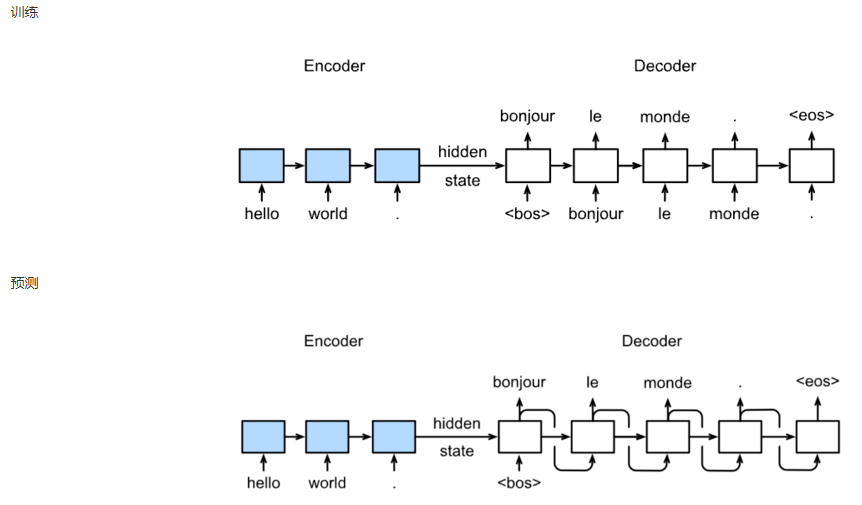
Specific structure: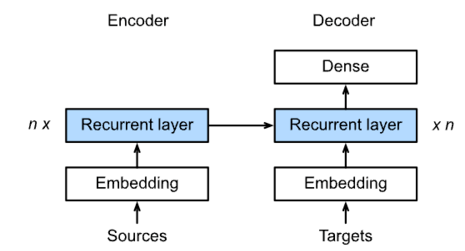
Code implementation: Encoder
class Seq2SeqEncoder(d2l.Encoder): def __init__(self, vocab_size, embed_size, num_hiddens, num_layers, dropout=0, **kwargs): super(Seq2SeqEncoder, self).__init__(**kwargs) self.num_hiddens=num_hiddens self.num_layers=num_layers self.embedding = nn.Embedding(vocab_size, embed_size) self.rnn = nn.LSTM(embed_size,num_hiddens, num_layers, dropout=dropout) def begin_state(self, batch_size, device): return [torch.zeros(size=(self.num_layers, batch_size, self.num_hiddens), device=device), torch.zeros(size=(self.num_layers, batch_size, self.num_hiddens), device=device)] def forward(self, X, *args): X = self.embedding(X) # X shape: (batch_size, seq_len, embed_size) X = X.transpose(0, 1) # RNN needs first axes to be time # state = self.begin_state(X.shape[1], device=X.device) out, state = self.rnn(X) # The shape of out is (seq_len, batch_size, num_hiddens). # state contains the hidden state and the memory cell # of the last time step, the shape is (num_layers, batch_size, num_hiddens) return out, state
Decoder
class Seq2SeqDecoder(d2l.Decoder): def __init__(self, vocab_size, embed_size, num_hiddens, num_layers, dropout=0, **kwargs): super(Seq2SeqDecoder, self).__init__(**kwargs) self.embedding = nn.Embedding(vocab_size, embed_size) self.rnn = nn.LSTM(embed_size,num_hiddens, num_layers, dropout=dropout) self.dense = nn.Linear(num_hiddens,vocab_size) def init_state(self, enc_outputs, *args): return enc_outputs[1] def forward(self, X, state): X = self.embedding(X).transpose(0, 1) out, state = self.rnn(X, state) # Make the batch to be the first dimension to simplify loss computation. out = self.dense(out).transpose(0, 1) return out, state
loss function
Because the padding structure is used, the loss function needs to be modified on the original CrossEntropy. First, the sequence mask function is used to determine the effective digits and then the loss is calculated
def SequenceMask(X, X_len,value=0): maxlen = X.size(1) mask = torch.arange(maxlen)[None, :].to(X_len.device) < X_len[:, None] X[~mask]=value return X class MaskedSoftmaxCELoss(nn.CrossEntropyLoss): # pred shape: (batch_size, seq_len, vocab_size) # label shape: (batch_size, seq_len) # valid_length shape: (batch_size, ) def forward(self, pred, label, valid_length): # the sample weights shape should be (batch_size, seq_len) weights = torch.ones_like(label) weights = SequenceMask(weights, valid_length).float() self.reduction='none' output=super(MaskedSoftmaxCELoss, self).forward(pred.transpose(1,2), label) return (output*weights).mean(dim=1)
train
def train_ch7(model, data_iter, lr, num_epochs, device): # Saved in d2l model.to(device) optimizer = optim.Adam(model.parameters(), lr=lr) loss = MaskedSoftmaxCELoss() tic = time.time() for epoch in range(1, num_epochs+1): l_sum, num_tokens_sum = 0.0, 0.0 for batch in data_iter: optimizer.zero_grad() X, X_vlen, Y, Y_vlen = [x.to(device) for x in batch] Y_input, Y_label, Y_vlen = Y[:,:-1], Y[:,1:], Y_vlen-1 Y_hat, _ = model(X, Y_input, X_vlen, Y_vlen) l = loss(Y_hat, Y_label, Y_vlen).sum() l.backward() with torch.no_grad(): d2l.grad_clipping_nn(model, 5, device) num_tokens = Y_vlen.sum().item() optimizer.step() l_sum += l.sum().item() num_tokens_sum += num_tokens if epoch % 50 == 0: print("epoch {0:4d},loss {1:.3f}, time {2:.1f} sec".format( epoch, (l_sum/num_tokens_sum), time.time()-tic)) tic = time.time() embed_size, num_hiddens, num_layers, dropout = 32, 32, 2, 0.0 batch_size, num_examples, max_len = 64, 1e3, 10 lr, num_epochs, ctx = 0.005, 300, d2l.try_gpu() src_vocab, tgt_vocab, train_iter = d2l.load_data_nmt( batch_size, max_len,num_examples) encoder = Seq2SeqEncoder( len(src_vocab), embed_size, num_hiddens, num_layers, dropout) decoder = Seq2SeqDecoder( len(tgt_vocab), embed_size, num_hiddens, num_layers, dropout) model = d2l.EncoderDecoder(encoder, decoder) train_ch7(model, train_iter, lr, num_epochs, ctx)
test
def translate_ch7(model, src_sentence, src_vocab, tgt_vocab, max_len, device): src_tokens = src_vocab[src_sentence.lower().split(' ')] src_len = len(src_tokens) if src_len < max_len: src_tokens += [src_vocab.pad] * (max_len - src_len) enc_X = torch.tensor(src_tokens, device=device) enc_valid_length = torch.tensor([src_len], device=device) # use expand_dim to add the batch_size dimension. enc_outputs = model.encoder(enc_X.unsqueeze(dim=0), enc_valid_length) dec_state = model.decoder.init_state(enc_outputs, enc_valid_length) dec_X = torch.tensor([tgt_vocab.bos], device=device).unsqueeze(dim=0) predict_tokens = [] for _ in range(max_len): Y, dec_state = model.decoder(dec_X, dec_state) # The token with highest score is used as the next time step input. dec_X = Y.argmax(dim=2) py = dec_X.squeeze(dim=0).int().item() if py == tgt_vocab.eos: break predict_tokens.append(py) return ' '.join(tgt_vocab.to_tokens(predict_tokens)) for sentence in ['Go .', 'Wow !', "I'm OK .", 'I won !']: print(sentence + ' => ' + translate_ch7( model, sentence, src_vocab, tgt_vocab, max_len, ctx))
Beam Search
Cluster search finds out the n words with the highest prediction probability each time to replace the word with the highest original selection probability.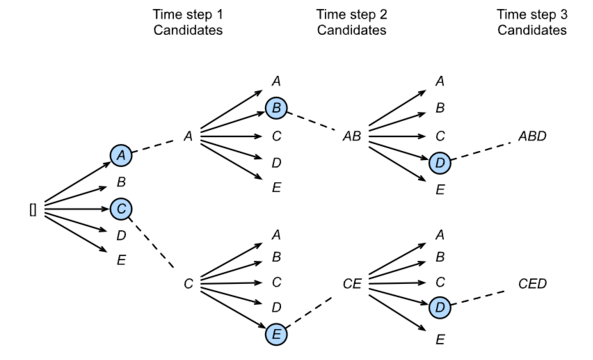
2, Attention mechanism and Seq2Seq model
In the "encoder decoder (seq2seq)" section, the decoder relies on the same context vector to obtain input sequence information in each time step. When the encoder is a cyclic neural network, the background variable is used to hide the final time step. The source sequence input information is encoded in a cyclic unit state and then passed to the decoder to generate the target sequence. However, there are some problems with this structure, especially the problem of long-range gradient disappearing in RNN mechanism. For long sentences, it is very difficult for us to hope to save all the effective information by transforming the input sequence into a fixed length vector. Therefore, with the increase of the length of the required translation sentence, the effect of this structure will decline significantly.
At the same time, the decoded target words may only be related to part of the original input words, not all the input words. For example, when "Hello world" is translated into "Bonjour Le Monte," hello "is mapped to" Bonjour "and" world "to" Monte ". In the seq2seq model, the decoder can only implicitly select the corresponding information from the final state of the encoder. However, attention mechanism can explicitly model the selection process.
Attention mechanism framework
Attention is a general pooling method with weight. The input consists of two parts: query and key-value pairs. The attention layer gets the output consistent with the dimension of value. For a query, the attention layer calculates the attention score with each key and normalizes the weight. The output vector is the weighted sum of value, and the weight calculated by each key corresponds to value one by one.
To calculate the output, we first assume that there is a function to calculate the similarity between query and key, and then we can calculate all the attention scores.
We use the softmax function to get the attention weight:
The final output is the weighted sum of value s:
The difference between different attention layers lies in the choice of score function. In the rest of this section, we will discuss two commonly used attention layers, dot product attention and Multilayer Perceptron Attention. Then we will implement a seq2seq model with attention and train and test it on English French translation corpus.
Import package
import math import torch import torch.nn as nn import os def file_name_walk(file_dir): for root, dirs, files in os.walk(file_dir): # print("root", root) # Current directory path print("dirs", dirs) # All subdirectories under the current path print("files", files) # All non directory sub files under the current path file_name_walk("/home/kesci/input/fraeng6506")
softmax shield
def SequenceMask(X, X_len,value=-1e6): maxlen = X.size(1) #print(X.size(),torch.arange((maxlen),dtype=torch.float)[None, :],'\n',X_len[:, None] ) mask = torch.arange((maxlen),dtype=torch.float)[None, :] >= X_len[:, None] #print(mask) X[mask]=value return X def masked_softmax(X, valid_length): # X: 3-D tensor, valid_length: 1-D or 2-D tensor softmax = nn.Softmax(dim=-1) if valid_length is None: return softmax(X) else: shape = X.shape if valid_length.dim() == 1: try: valid_length = torch.FloatTensor(valid_length.numpy().repeat(shape[1], axis=0))#[2,2,3,3] except: valid_length = torch.FloatTensor(valid_length.cpu().numpy().repeat(shape[1], axis=0))#[2,2,3,3] else: valid_length = valid_length.reshape((-1,)) # fill masked elements with a large negative, whose exp is 0 X = SequenceMask(X.reshape((-1, shape[-1])), valid_length) return softmax(X).reshape(shape)
Point product attention

class DotProductAttention(nn.Module): def __init__(self, dropout, **kwargs): super(DotProductAttention, self).__init__(**kwargs) self.dropout = nn.Dropout(dropout) # query: (batch_size, #queries, d) # key: (batch_size, #kv_pairs, d) # value: (batch_size, #kv_pairs, dim_v) # valid_length: either (batch_size, ) or (batch_size, xx) def forward(self, query, key, value, valid_length=None): d = query.shape[-1] # set transpose_b=True to swap the last two dimensions of key scores = torch.bmm(query, key.transpose(1,2)) / math.sqrt(d) attention_weights = self.dropout(masked_softmax(scores, valid_length)) print("attention_weight\n",attention_weights) return torch.bmm(attention_weights, value)
Attention of multi-layer perceptron

# Save to the d2l package. class MLPAttention(nn.Module): def __init__(self, units,ipt_dim,dropout, **kwargs): super(MLPAttention, self).__init__(**kwargs) # Use flatten=True to keep query's and key's 3-D shapes. self.W_k = nn.Linear(ipt_dim, units, bias=False) self.W_q = nn.Linear(ipt_dim, units, bias=False) self.v = nn.Linear(units, 1, bias=False) self.dropout = nn.Dropout(dropout) def forward(self, query, key, value, valid_length): query, key = self.W_k(query), self.W_q(key) #print("size",query.size(),key.size()) # expand query to (batch_size, #querys, 1, units), and key to # (batch_size, 1, #kv_pairs, units). Then plus them with broadcast. features = query.unsqueeze(2) + key.unsqueeze(1) #print("features:",features.size()) #--------------On scores = self.v(features).squeeze(-1) attention_weights = self.dropout(masked_softmax(scores, valid_length)) return torch.bmm(attention_weights, value)
Seq2seq model with attention mechanism
In this section, the attention mechanism is added to the sequence to sequence model to explicitly aggregate states using weights. The following figure shows the model structure of encoding and decoding, when the time step is t. At the moment, the attention layer holds all the information that encoding sees - the output of each step of encoding. In the coding stage, the hidden state of decoder's time is treated as query, and the hidden states of each time step of encoder are used as key and value for attention aggregation. The output of attention model is treated as context vector, and is spliced with decoder input and sent to decoder:
The following figure shows the relationship between all layers of seq2seq mechanism, and the layer structure of encoder and decoder
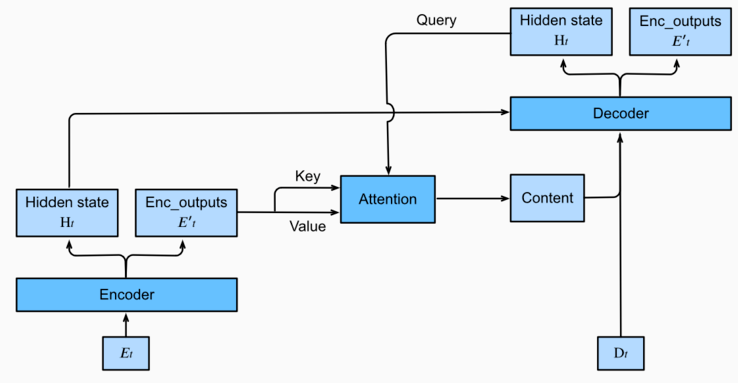
Decoder
Since the encoder of seq2seq with attention mechanism is the same as Seq2SeqEncoder in the previous chapter, we only focus on the decoder here. We added an MLP attention layer (MLPAttention), which has the same hidden size as the LSTM layer in the decoder. Then we initialize the state of the decoder by passing three parameters from the encoder:
1.the encoder outputs of all timesteps: each state of the encoder output is used in the memory part of the attachment layer, with the same key and values
2.the hidden state of the encoder's final timestep: the hidden state of the last time step of the encoder, used to initialize the decoder's hidden state
3.the encoder valid length: the effective length of the encoder, by which the layer will not consider the padding in the encoder output
At each time step of decoding, we use the output of the last RNN layer of the decoder as the query of the attention layer. Then, the output of the attention model is connected with the input embedding vector and input to the RNN layer. Although the hidden state of RNN layer also contains the historical information from decoder, the output of attention model explicitly selects the encoder output within enc_valid_len, so that the attention mechanism will exclude other irrelevant information as much as possible.
class Seq2SeqAttentionDecoder(d2l.Decoder): def __init__(self, vocab_size, embed_size, num_hiddens, num_layers, dropout=0, **kwargs): super(Seq2SeqAttentionDecoder, self).__init__(**kwargs) self.attention_cell = MLPAttention(num_hiddens,num_hiddens, dropout) self.embedding = nn.Embedding(vocab_size, embed_size) self.rnn = nn.LSTM(embed_size+ num_hiddens,num_hiddens, num_layers, dropout=dropout) self.dense = nn.Linear(num_hiddens,vocab_size) def init_state(self, enc_outputs, enc_valid_len, *args): outputs, hidden_state = enc_outputs # print("first:",outputs.size(),hidden_state[0].size(),hidden_state[1].size()) # Transpose outputs to (batch_size, seq_len, hidden_size) return (outputs.permute(1,0,-1), hidden_state, enc_valid_len) #outputs.swapaxes(0, 1) def forward(self, X, state): enc_outputs, hidden_state, enc_valid_len = state #("X.size",X.size()) X = self.embedding(X).transpose(0,1) # print("Xembeding.size2",X.size()) outputs = [] for l, x in enumerate(X): # print(f"\n{l}-th token") # print("x.first.size()",x.size()) # query shape: (batch_size, 1, hidden_size) # select hidden state of the last rnn layer as query query = hidden_state[0][-1].unsqueeze(1) # np.expand_dims(hidden_state[0][-1], axis=1) # context has same shape as query # print("query enc_outputs, enc_outputs:\n",query.size(), enc_outputs.size(), enc_outputs.size()) context = self.attention_cell(query, enc_outputs, enc_outputs, enc_valid_len) # Concatenate on the feature dimension # print("context.size:",context.size()) x = torch.cat((context, x.unsqueeze(1)), dim=-1) # Reshape x to (1, batch_size, embed_size+hidden_size) # print("rnn",x.size(), len(hidden_state)) out, hidden_state = self.rnn(x.transpose(0,1), hidden_state) outputs.append(out) outputs = self.dense(torch.cat(outputs, dim=0)) return outputs.transpose(0, 1), [enc_outputs, hidden_state, enc_valid_len]
Now we can use the attention model to test seq2seq. In order to be consistent with the model in section 9.7, we use the same super parameters for vocab? Size, embedded? Size, Num? Hiddens, and num? Layers. As a result, we get the same decoder output shape, but the state structure changes.
encoder = d2l.Seq2SeqEncoder(vocab_size=10, embed_size=8, num_hiddens=16, num_layers=2) # encoder.initialize() decoder = Seq2SeqAttentionDecoder(vocab_size=10, embed_size=8, num_hiddens=16, num_layers=2) X = torch.zeros((4, 7),dtype=torch.long) print("batch size=4\nseq_length=7\nhidden dim=16\nnum_layers=2\n") print('encoder output size:', encoder(X)[0].size()) print('encoder hidden size:', encoder(X)[1][0].size()) print('encoder memory size:', encoder(X)[1][1].size()) state = decoder.init_state(encoder(X), None) out, state = decoder(X, state) out.shape, len(state), state[0].shape, len(state[1]), state[1][0].shape
train
import zipfile import torch import requests from io import BytesIO from torch.utils import data import sys import collections class Vocab(object): # This class is saved in d2l. def __init__(self, tokens, min_freq=0, use_special_tokens=False): # sort by frequency and token counter = collections.Counter(tokens) token_freqs = sorted(counter.items(), key=lambda x: x[0]) token_freqs.sort(key=lambda x: x[1], reverse=True) if use_special_tokens: # padding, begin of sentence, end of sentence, unknown self.pad, self.bos, self.eos, self.unk = (0, 1, 2, 3) tokens = ['', '', '', ''] else: self.unk = 0 tokens = [''] tokens += [token for token, freq in token_freqs if freq >= min_freq] self.idx_to_token = [] self.token_to_idx = dict() for token in tokens: self.idx_to_token.append(token) self.token_to_idx[token] = len(self.idx_to_token) - 1 def __len__(self): return len(self.idx_to_token) def __getitem__(self, tokens): if not isinstance(tokens, (list, tuple)): return self.token_to_idx.get(tokens, self.unk) else: return [self.__getitem__(token) for token in tokens] def to_tokens(self, indices): if not isinstance(indices, (list, tuple)): return self.idx_to_token[indices] else: return [self.idx_to_token[index] for index in indices] def load_data_nmt(batch_size, max_len, num_examples=1000): """Download an NMT dataset, return its vocabulary and data iterator.""" # Download and preprocess def preprocess_raw(text): text = text.replace('\u202f', ' ').replace('\xa0', ' ') out = '' for i, char in enumerate(text.lower()): if char in (',', '!', '.') and text[i-1] != ' ': out += ' ' out += char return out with open('/home/kesci/input/fraeng6506/fra.txt', 'r') as f: raw_text = f.read() text = preprocess_raw(raw_text) # Tokenize source, target = [], [] for i, line in enumerate(text.split('\n')): if i >= num_examples: break parts = line.split('\t') if len(parts) >= 2: source.append(parts[0].split(' ')) target.append(parts[1].split(' ')) # Build vocab def build_vocab(tokens): tokens = [token for line in tokens for token in line] return Vocab(tokens, min_freq=3, use_special_tokens=True) src_vocab, tgt_vocab = build_vocab(source), build_vocab(target) # Convert to index arrays def pad(line, max_len, padding_token): if len(line) > max_len: return line[:max_len] return line + [padding_token] * (max_len - len(line)) def build_array(lines, vocab, max_len, is_source): lines = [vocab[line] for line in lines] if not is_source: lines = [[vocab.bos] + line + [vocab.eos] for line in lines] array = torch.tensor([pad(line, max_len, vocab.pad) for line in lines]) valid_len = (array != vocab.pad).sum(1) return array, valid_len src_vocab, tgt_vocab = build_vocab(source), build_vocab(target) src_array, src_valid_len = build_array(source, src_vocab, max_len, True) tgt_array, tgt_valid_len = build_array(target, tgt_vocab, max_len, False) train_data = data.TensorDataset(src_array, src_valid_len, tgt_array, tgt_valid_len) train_iter = data.DataLoader(train_data, batch_size, shuffle=True) return src_vocab, tgt_vocab, train_iter embed_size, num_hiddens, num_layers, dropout = 32, 32, 2, 0.0 batch_size, num_steps = 64, 10 lr, num_epochs, ctx = 0.005, 500, d2l.try_gpu() src_vocab, tgt_vocab, train_iter = load_data_nmt(batch_size, num_steps) encoder = d2l.Seq2SeqEncoder( len(src_vocab), embed_size, num_hiddens, num_layers, dropout) decoder = Seq2SeqAttentionDecoder( len(tgt_vocab), embed_size, num_hiddens, num_layers, dropout) model = d2l.EncoderDecoder(encoder, decoder) d2l.train_s2s_ch9(model, train_iter, lr, num_epochs, ctx)
3, Transformer
In the previous chapters, we have introduced the main neural network architecture, such as convolutional neural network (CNNs) and cyclic neural network (RNNs). Let's review:
1. CNN is easy to parallelize, but it is not suitable to capture the dependency in the variable length sequence.
2.RNNs is suitable for capturing the dependence of long-distance variable length sequences, but it is difficult to realize parallel processing sequences.
In order to integrate the advantages of CNN and RNN, [Vaswani et al., 2017] innovatively designed Transformer model using attention mechanism. This model uses the attention mechanism to realize the parallel capture of sequence dependency, and simultaneously processes the tokens of each position of the sequence. The above advantages make the Transformer model have excellent performance and greatly reduce the training time.
Figure 10.3.1 shows the architecture of transformer model, which is similar to seq2seq model in section 9.7. Transformer is also based on encoder decoder architecture, with the following three main differences:
1.Transformer blocks: replace the cyclic network of seq2seq model with Transformer Blocks. The module includes a multi head attention layer and two position wise feed forward networks (FFN). For the decoder, another multi attention layer is used to accept the hidden state of the encoder.
2.Add and norm: the output of multi attention layer and feedforward network is sent to two "add and norm" layers for processing, which include residual structure and layer normalization.
3.Position encoding: since the self attention layer does not distinguish the order of elements, a position encoding layer is used to add position information to sequence elements.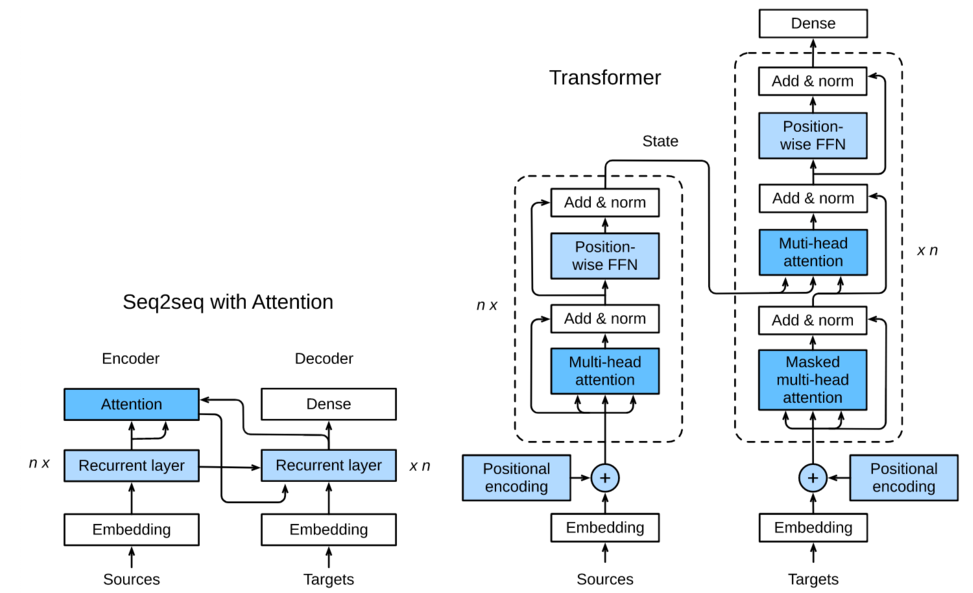
import os import math import numpy as np import torch import torch.nn as nn import torch.nn.functional as F import sys sys.path.append('/home/kesci/input/d2len9900') import d2l #The following functions are the contents of the previous section def SequenceMask(X, X_len,value=-1e6): maxlen = X.size(1) X_len = X_len.to(X.device) #print(X.size(),torch.arange((maxlen),dtype=torch.float)[None, :],'\n',X_len[:, None] ) mask = torch.arange((maxlen), dtype=torch.float, device=X.device) mask = mask[None, :] < X_len[:, None] #print(mask) X[~mask]=value return X def masked_softmax(X, valid_length): # X: 3-D tensor, valid_length: 1-D or 2-D tensor softmax = nn.Softmax(dim=-1) if valid_length is None: return softmax(X) else: shape = X.shape if valid_length.dim() == 1: try: valid_length = torch.FloatTensor(valid_length.numpy().repeat(shape[1], axis=0))#[2,2,3,3] except: valid_length = torch.FloatTensor(valid_length.cpu().numpy().repeat(shape[1], axis=0))#[2,2,3,3] else: valid_length = valid_length.reshape((-1,)) # fill masked elements with a large negative, whose exp is 0 X = SequenceMask(X.reshape((-1, shape[-1])), valid_length) return softmax(X).reshape(shape) # Save to the d2l package. class DotProductAttention(nn.Module): def __init__(self, dropout, **kwargs): super(DotProductAttention, self).__init__(**kwargs) self.dropout = nn.Dropout(dropout) # query: (batch_size, #queries, d) # key: (batch_size, #kv_pairs, d) # value: (batch_size, #kv_pairs, dim_v) # valid_length: either (batch_size, ) or (batch_size, xx) def forward(self, query, key, value, valid_length=None): d = query.shape[-1] # set transpose_b=True to swap the last two dimensions of key scores = torch.bmm(query, key.transpose(1,2)) / math.sqrt(d) attention_weights = self.dropout(masked_softmax(scores, valid_length)) return torch.bmm(attention_weights, value)
Multiple attention level
Before we discuss the multi attention layer, let's quickly understand the following structure of self attention. Self attention model is a normal attention model. The key, value and query corresponding to each element of the sequence are completely consistent. As shown in the figure below, self attention outputs a representation sequence with the same length as the input. Compared with the cyclic neural network, the calculation of self attention for each element output is parallel, so we can effectively implement this module.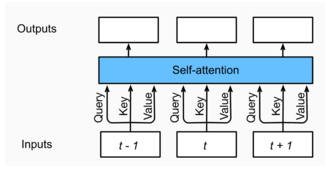
The multi attention layer consists of H parallel self attention layers, each of which is called a head. For each header, before attention calculation, we will map query, key and value with three current layers, and the output of these h attention headers will be spliced and input into the last linear layer for integration.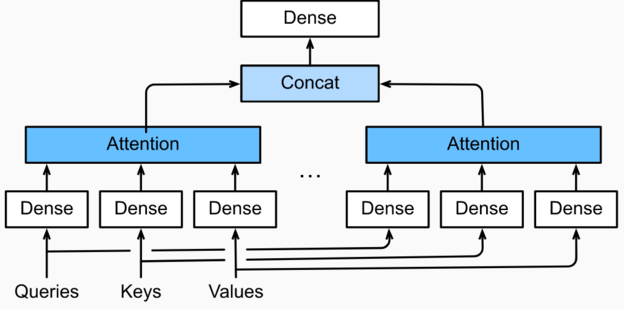

class MultiHeadAttention(nn.Module): def __init__(self, input_size, hidden_size, num_heads, dropout, **kwargs): super(MultiHeadAttention, self).__init__(**kwargs) self.num_heads = num_heads self.attention = DotProductAttention(dropout) self.W_q = nn.Linear(input_size, hidden_size, bias=False) self.W_k = nn.Linear(input_size, hidden_size, bias=False) self.W_v = nn.Linear(input_size, hidden_size, bias=False) self.W_o = nn.Linear(hidden_size, hidden_size, bias=False) def forward(self, query, key, value, valid_length): # query, key, and value shape: (batch_size, seq_len, dim), # where seq_len is the length of input sequence # valid_length shape is either (batch_size, ) # or (batch_size, seq_len). # Project and transpose query, key, and value from # (batch_size, seq_len, hidden_size * num_heads) to # (batch_size * num_heads, seq_len, hidden_size). query = transpose_qkv(self.W_q(query), self.num_heads) key = transpose_qkv(self.W_k(key), self.num_heads) value = transpose_qkv(self.W_v(value), self.num_heads) if valid_length is not None: # Copy valid_length by num_heads times device = valid_length.device valid_length = valid_length.cpu().numpy() if valid_length.is_cuda else valid_length.numpy() if valid_length.ndim == 1: valid_length = torch.FloatTensor(np.tile(valid_length, self.num_heads)) else: valid_length = torch.FloatTensor(np.tile(valid_length, (self.num_heads,1))) valid_length = valid_length.to(device) output = self.attention(query, key, value, valid_length) output_concat = transpose_output(output, self.num_heads) return self.W_o(output_concat) def transpose_qkv(X, num_heads): # Original X shape: (batch_size, seq_len, hidden_size * num_heads), # -1 means inferring its value, after first reshape, X shape: # (batch_size, seq_len, num_heads, hidden_size) X = X.view(X.shape[0], X.shape[1], num_heads, -1) # After transpose, X shape: (batch_size, num_heads, seq_len, hidden_size) X = X.transpose(2, 1).contiguous() # Merge the first two dimensions. Use reverse=True to infer shape from # right to left. # output shape: (batch_size * num_heads, seq_len, hidden_size) output = X.view(-1, X.shape[2], X.shape[3]) return output # Saved in the d2l package for later use def transpose_output(X, num_heads): # A reversed version of transpose_qkv X = X.view(-1, num_heads, X.shape[1], X.shape[2]) X = X.transpose(2, 1).contiguous() return X.view(X.shape[0], X.shape[1], -1)
Position based feedforward network
Another very important part of the Transformer module is the position based feedforward network (FFN), which accepts a three-dimensional tensor with the shape of (batch size, SEQ length, feature size). Position wise FFN consists of two fully connected layers, which act on the last dimension. Because the state of each position of the sequence is updated separately, we call it position wise, which is equivalent to a convolution of 1x1.
Let's implement PositionWiseFFN:
# Save to the d2l package. class PositionWiseFFN(nn.Module): def __init__(self, input_size, ffn_hidden_size, hidden_size_out, **kwargs): super(PositionWiseFFN, self).__init__(**kwargs) self.ffn_1 = nn.Linear(input_size, ffn_hidden_size) self.ffn_2 = nn.Linear(ffn_hidden_size, hidden_size_out) def forward(self, X): return self.ffn_2(F.relu(self.ffn_1(X)))
Similar to the multi attention layer, the FFN layer only changes the size of the last dimension; in addition, for two identical inputs, the output of the FFN layer will be equal.
Add and Norm
In addition to the above two modules, Transformer also has an important additive normalization layer, which can smoothly integrate the input and the output of other layers, so we add a Layer Norm layer with residual connection behind each multi attention layer and FFN layer. Here, Layer Norm is very similar to Batch Norm in section 7.5. The only difference is that Batch Norm calculates the mean and variance of batch size, while Layer Norm calculates the last dimension. Layer normalization can prevent the numerical changes in the layer from being too large, which is helpful to speed up the training speed and improve the generalization performance.
# Save to the d2l package. class AddNorm(nn.Module): def __init__(self, hidden_size, dropout, **kwargs): super(AddNorm, self).__init__(**kwargs) self.dropout = nn.Dropout(dropout) self.norm = nn.LayerNorm(hidden_size) def forward(self, X, Y): return self.norm(self.dropout(Y) + X)
Position encoding

class PositionalEncoding(nn.Module): def __init__(self, embedding_size, dropout, max_len=1000): super(PositionalEncoding, self).__init__() self.dropout = nn.Dropout(dropout) self.P = np.zeros((1, max_len, embedding_size)) X = np.arange(0, max_len).reshape(-1, 1) / np.power( 10000, np.arange(0, embedding_size, 2)/embedding_size) self.P[:, :, 0::2] = np.sin(X) self.P[:, :, 1::2] = np.cos(X) self.P = torch.FloatTensor(self.P) def forward(self, X): if X.is_cuda and not self.P.is_cuda: self.P = self.P.cuda() X = X + self.P[:, :X.shape[1], :] return self.dropout(X)
Encoder
We have all the modules that make up Transformer, now we can start to build it! The encoder consists of a multi attention layer, a position wise FFN, and two Add and Norm layers. For the attention model and FFN model, our output dimension is consistent with the embedding dimension, which is also caused by the inherent characteristics of residual connection, because we want to add and normalize the output of the previous layer and the original input.
class EncoderBlock(nn.Module): def __init__(self, embedding_size, ffn_hidden_size, num_heads, dropout, **kwargs): super(EncoderBlock, self).__init__(**kwargs) self.attention = MultiHeadAttention(embedding_size, embedding_size, num_heads, dropout) self.addnorm_1 = AddNorm(embedding_size, dropout) self.ffn = PositionWiseFFN(embedding_size, ffn_hidden_size, embedding_size) self.addnorm_2 = AddNorm(embedding_size, dropout) def forward(self, X, valid_length): Y = self.addnorm_1(X, self.attention(X, X, X, valid_length)) return self.addnorm_2(Y, self.ffn(Y))
Now let's implement the whole Transformer encoder model. The whole encoder is made up of n just defined encoder blocks. Because of the residual connection, the dimension of the intermediate state is always consistent with the dimension d of the embedded vector. At the same time, we notice that we multiply the embedded vector by the root sign d to prevent its value from being too small.
class TransformerEncoder(d2l.Encoder): def __init__(self, vocab_size, embedding_size, ffn_hidden_size, num_heads, num_layers, dropout, **kwargs): super(TransformerEncoder, self).__init__(**kwargs) self.embedding_size = embedding_size self.embed = nn.Embedding(vocab_size, embedding_size) self.pos_encoding = PositionalEncoding(embedding_size, dropout) self.blks = nn.ModuleList() for i in range(num_layers): self.blks.append( EncoderBlock(embedding_size, ffn_hidden_size, num_heads, dropout)) def forward(self, X, valid_length, *args): X = self.pos_encoding(self.embed(X) * math.sqrt(self.embedding_size)) for blk in self.blks: X = blk(X, valid_length) return X
Decoder
The decoder of the Transformer model is similar to the encoder structure, however, there is another sub module in the encoder part in addition to the modules previously described. The module is also a multi attention layer, which takes the output of encoder as key and value, and the state of decoder as query. Similar to the encoder part, the decoder also uses the add and norm mechanism to connect the output of each sub layer with residual and layer normalization.
Carefully speaking, in step T, if the current input Xt is query, then self attention accepts all the input from step T and the previous t-1. In training, because the input of the T position can observe all the sequences, which is inconsistent with the situation item in the prediction stage, we should set the observable length corresponding to the t time step to t to eliminate the future information that we do not need to see.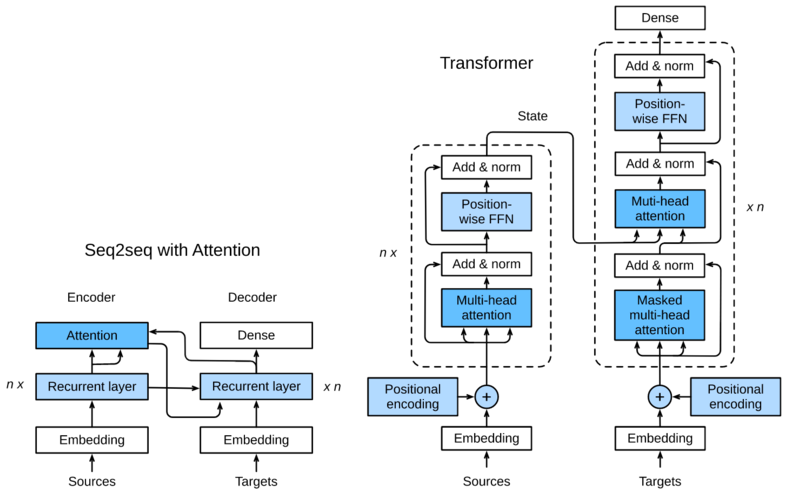
class DecoderBlock(nn.Module): def __init__(self, embedding_size, ffn_hidden_size, num_heads,dropout,i,**kwargs): super(DecoderBlock, self).__init__(**kwargs) self.i = i self.attention_1 = MultiHeadAttention(embedding_size, embedding_size, num_heads, dropout) self.addnorm_1 = AddNorm(embedding_size, dropout) self.attention_2 = MultiHeadAttention(embedding_size, embedding_size, num_heads, dropout) self.addnorm_2 = AddNorm(embedding_size, dropout) self.ffn = PositionWiseFFN(embedding_size, ffn_hidden_size, embedding_size) self.addnorm_3 = AddNorm(embedding_size, dropout) def forward(self, X, state): enc_outputs, enc_valid_length = state[0], state[1] # state[2][self.i] stores all the previous t-1 query state of layer-i # len(state[2]) = num_layers # If training: # state[2] is useless. # If predicting: # In the t-th timestep: # state[2][self.i].shape = (batch_size, t-1, hidden_size) # Demo: # love dogs ! [EOS] # | | | | # Transformer # Decoder # | | | | # I love dogs ! if state[2][self.i] is None: key_values = X else: # shape of key_values = (batch_size, t, hidden_size) key_values = torch.cat((state[2][self.i], X), dim=1) state[2][self.i] = key_values if self.training: batch_size, seq_len, _ = X.shape # Shape: (batch_size, seq_len), the values in the j-th column are j+1 valid_length = torch.FloatTensor(np.tile(np.arange(1, seq_len+1), (batch_size, 1))) valid_length = valid_length.to(X.device) else: valid_length = None X2 = self.attention_1(X, key_values, key_values, valid_length) Y = self.addnorm_1(X, X2) Y2 = self.attention_2(Y, enc_outputs, enc_outputs, enc_valid_length) Z = self.addnorm_2(Y, Y2) return self.addnorm_3(Z, self.ffn(Z)), state
For the Transformer Decoder, it is constructed in the same way as the encoder, except that the last layer adds a deny layer to obtain the confidence score of the output. Next, let's implement Transformer Decoder. In addition to the normal super parameters such as vocab ﹐ size embedding ﹐ size, the decoder also needs the output enc ﹐ outputs of the encoder and the effective sentence length enc ﹐ valid ﹐ length.
class TransformerDecoder(d2l.Decoder): def __init__(self, vocab_size, embedding_size, ffn_hidden_size, num_heads, num_layers, dropout, **kwargs): super(TransformerDecoder, self).__init__(**kwargs) self.embedding_size = embedding_size self.num_layers = num_layers self.embed = nn.Embedding(vocab_size, embedding_size) self.pos_encoding = PositionalEncoding(embedding_size, dropout) self.blks = nn.ModuleList() for i in range(num_layers): self.blks.append( DecoderBlock(embedding_size, ffn_hidden_size, num_heads, dropout, i)) self.dense = nn.Linear(embedding_size, vocab_size) def init_state(self, enc_outputs, enc_valid_length, *args): return [enc_outputs, enc_valid_length, [None]*self.num_layers] def forward(self, X, state): X = self.pos_encoding(self.embed(X) * math.sqrt(self.embedding_size)) for blk in self.blks: X, state = blk(X, state) return self.dense(X), state
train
import zipfile import torch import requests from io import BytesIO from torch.utils import data import sys import collections class Vocab(object): # This class is saved in d2l. def __init__(self, tokens, min_freq=0, use_special_tokens=False): # sort by frequency and token counter = collections.Counter(tokens) token_freqs = sorted(counter.items(), key=lambda x: x[0]) token_freqs.sort(key=lambda x: x[1], reverse=True) if use_special_tokens: # padding, begin of sentence, end of sentence, unknown self.pad, self.bos, self.eos, self.unk = (0, 1, 2, 3) tokens = ['', '', '', ''] else: self.unk = 0 tokens = [''] tokens += [token for token, freq in token_freqs if freq >= min_freq] self.idx_to_token = [] self.token_to_idx = dict() for token in tokens: self.idx_to_token.append(token) self.token_to_idx[token] = len(self.idx_to_token) - 1 def __len__(self): return len(self.idx_to_token) def __getitem__(self, tokens): if not isinstance(tokens, (list, tuple)): return self.token_to_idx.get(tokens, self.unk) else: return [self.__getitem__(token) for token in tokens] def to_tokens(self, indices): if not isinstance(indices, (list, tuple)): return self.idx_to_token[indices] else: return [self.idx_to_token[index] for index in indices] def load_data_nmt(batch_size, max_len, num_examples=1000): """Download an NMT dataset, return its vocabulary and data iterator.""" # Download and preprocess def preprocess_raw(text): text = text.replace('\u202f', ' ').replace('\xa0', ' ') out = '' for i, char in enumerate(text.lower()): if char in (',', '!', '.') and text[i-1] != ' ': out += ' ' out += char return out with open('/home/kesci/input/fraeng6506/fra.txt', 'r') as f: raw_text = f.read() text = preprocess_raw(raw_text) # Tokenize source, target = [], [] for i, line in enumerate(text.split('\n')): if i >= num_examples: break parts = line.split('\t') if len(parts) >= 2: source.append(parts[0].split(' ')) target.append(parts[1].split(' ')) # Build vocab def build_vocab(tokens): tokens = [token for line in tokens for token in line] return Vocab(tokens, min_freq=3, use_special_tokens=True) src_vocab, tgt_vocab = build_vocab(source), build_vocab(target) # Convert to index arrays def pad(line, max_len, padding_token): if len(line) > max_len: return line[:max_len] return line + [padding_token] * (max_len - len(line)) def build_array(lines, vocab, max_len, is_source): lines = [vocab[line] for line in lines] if not is_source: lines = [[vocab.bos] + line + [vocab.eos] for line in lines] array = torch.tensor([pad(line, max_len, vocab.pad) for line in lines]) valid_len = (array != vocab.pad).sum(1) return array, valid_len src_vocab, tgt_vocab = build_vocab(source), build_vocab(target) src_array, src_valid_len = build_array(source, src_vocab, max_len, True) tgt_array, tgt_valid_len = build_array(target, tgt_vocab, max_len, False) train_data = data.TensorDataset(src_array, src_valid_len, tgt_array, tgt_valid_len) train_iter = data.DataLoader(train_data, batch_size, shuffle=True) return src_vocab, tgt_vocab, train_iter import os import d2l # The platform does not support gpu temporarily. Now it will use cpu to train automatically. gpu will use gpu to train when it is ready os.environ["CUDA_VISIBLE_DEVICES"] = "1" embed_size, embedding_size, num_layers, dropout = 32, 32, 2, 0.05 batch_size, num_steps = 64, 10 lr, num_epochs, ctx = 0.005, 250, d2l.try_gpu() print(ctx) num_hiddens, num_heads = 64, 4 src_vocab, tgt_vocab, train_iter = load_data_nmt(batch_size, num_steps) encoder = TransformerEncoder( len(src_vocab), embedding_size, num_hiddens, num_heads, num_layers, dropout) decoder = TransformerDecoder( len(src_vocab), embedding_size, num_hiddens, num_heads, num_layers, dropout) model = d2l.EncoderDecoder(encoder, decoder) d2l.train_s2s_ch9(model, train_iter, lr, num_epochs, ctx)
Note:
All contents of this blog refer to the in-depth learning course of Boyu learning platform

